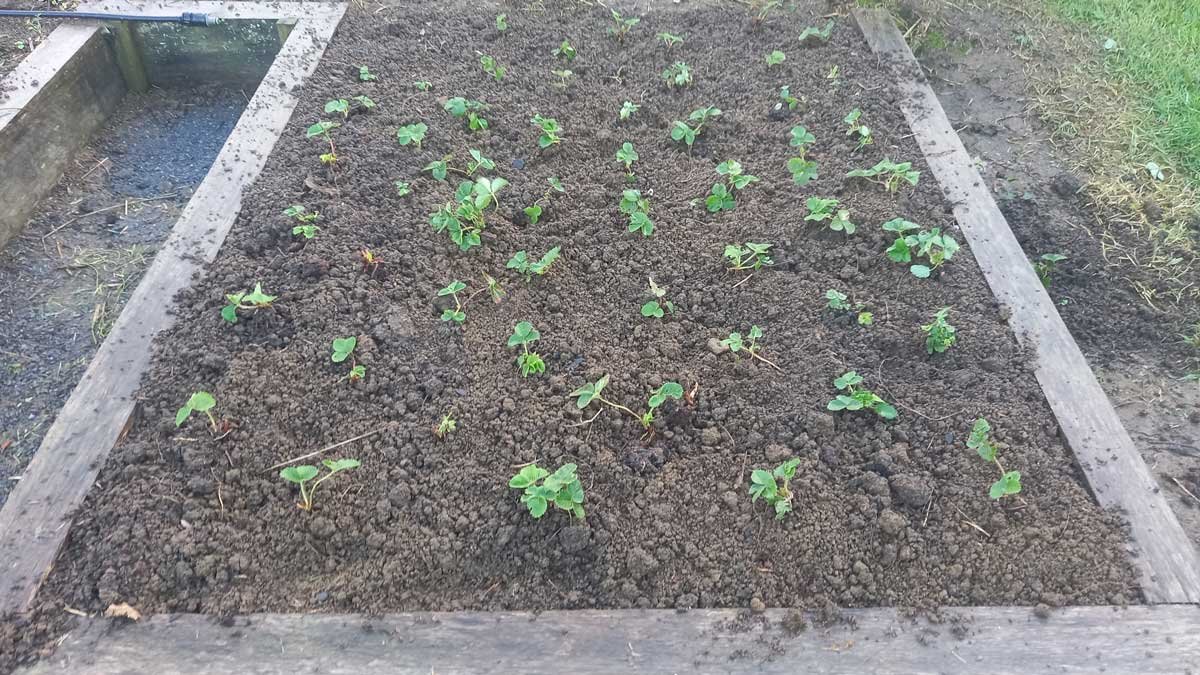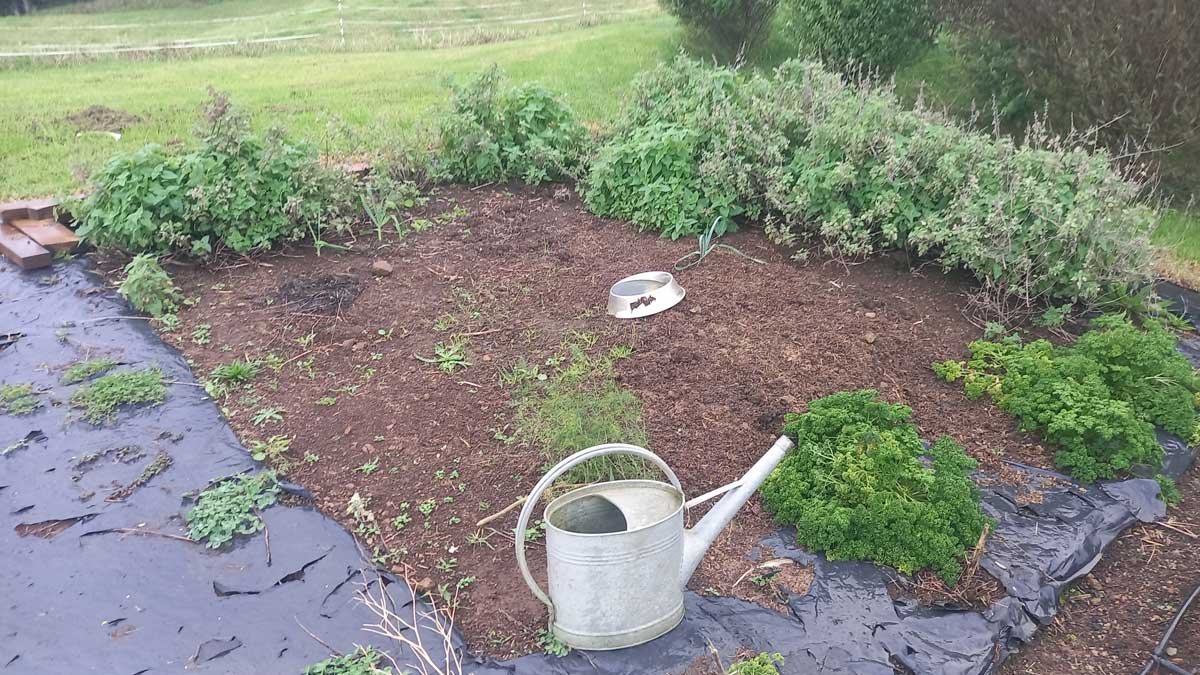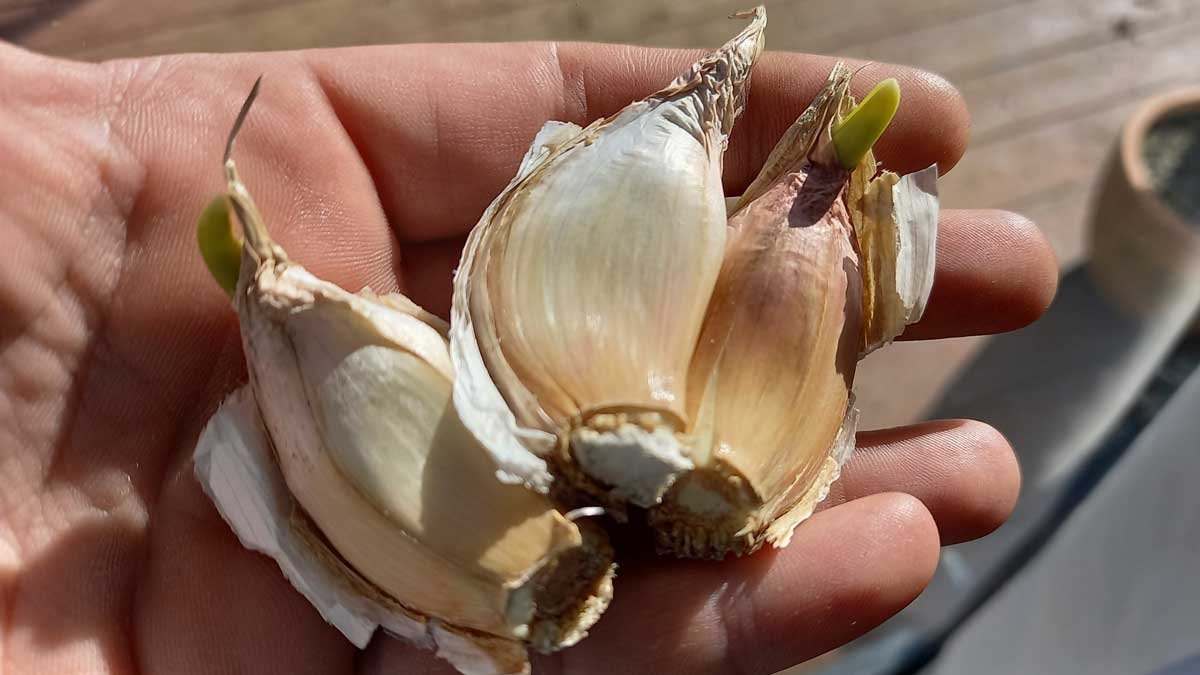I’ve said it before, winter is my favourite season in the garden. It helps a lot that I live in the ‘winterless north’. I was raised in a place that actually experienced winter and I often feel very grateful for the semi-tropical temperatures of my adopted home.
It’s too cold for tomatoes or cucumbers – they die back around May and have been cleared away. But without the stinging frost that comes with winters further south, it’s usually pretty enjoyable out in the garden at this time of year.
And I love the crops that come with winter – leeks, garlic, broccoli, cauliflower. Our winter dinners overflow with home-grown veggies. Well, when they grow.
The days might be annoyingly shorter, but they’re more usable in many ways. The harsh summer sun isn’t driving me towards more shady jobs (or a siesta). We just need to wear an extra layer when we go out there.
And I’ve been out there a lot this week. It’s not totally visible yet, but the garden is beginning to renew.
Strawberries
I was gutted to hear there’s been problems in the strawberry plant supply chain this year. I’d been planning to change out my old strawberry variety with a daylight-neutral one, but supply issues caused by weather and disease have made that difficult and expensive.
I might still add a few daylight-neutral berries to my collection yet, but for now I needed to get to work with what I have. Which was a giant hole in a messy (but not as messy as it could be) bed, and a compost bin that needed emptying.

Working section-by section, I lifted out all the strawberries; removed about 20cm of topsoil; then replaced it with 10cm of compost under 10-15cm of the topsoil.
There’s no photos because it was an incredibly muddy, annoying job. The sodden clay soils were crying out for the organic matter. I pulled out strong tap roots of clover and kikuyu runners as I went. Hopefully we’ve now eradicated them both.
Finally, I replanted way more strawberries than this bed can realistically hold. They’re in pretty average condition so I’m not expecting them all to survive. But enough should.

We’ll see how it goes. The compost will continue to decompose and the soil will shrink again. It still needs mulching and perhaps a barrier to stop the dogs trampling it. But hopefully it’ll be productive enough.
Time to plant garlic
Three of my garlic varieties are shooting and one is rotting, so it’s time to start getting that in the ground.
The ‘White Rocambole’, ‘Purple Rocambole’, and ‘Spanish Red’ were starting to shoot. This early sprouting habit is another piece of evidence that these varieties actually belong to the Turban garlic group.
On inspection, the ‘Russian Red’ (which I suspect might be part of the Rocambole group, just to be confusing) was starting to rot. I managed to find 14 cloves worth planting. A bit disappointing, but Rocamboles don’t keep well so it’s also a bit of evidence in figuring these things out.
If it is a Rocambole, it’s pretty likely that it won’t continue to grow in Northland long-term as they’re a cooler-season group. I’m OK with that if that’s what happens. But I’m not gonna let it stop me from trying.
I’ve probably got 250-300 garlic cloves to plant this year over all 6 varieties, so I figured I’d start with the ones that needed to get in the ground now. I chose a bed at the top of my garden because it has the best drainage. The day before planting, I went out and got it ready.
I added some blood and bone and gypsum, and raked it all in. Then I worked out how many cloves could go into the bed (about 130) and got the Russian Red, White Rocambole, and Purple Rocambole ready to plant.
The cloves I have for seed are absolutely enormous. Purple Rocambole on the left; White Rocambole on the right.
This year I decided to take Tasmanian Gourmet Garlic’s recommendation and bleach them for 3 minutes before planting. There’s definitely still some funky things going on after my nightmare year and I felt decontaminating the seed as much as possible would be an advantage this time round. I used a ratio of one part bleach to three parts water as recommended for sprouting garlic.
And then planted them on Thursday afternoon. So that’s three down, three to go. I expect I’ll clear the next bed for planting the Spanish Red in the coming week.
Brassica
The broccoli and cauliflower I planted back in March have matured. I’ve really struggled with this crop. First corn earworm marching in to eat it. Then bacterial soft rot.
It started with a huge dump of rain. I went out the next day to check on my garden and most the cauliflowers looked like this:

I was really confused at first, but then four cauliflower plants just basically rotted. One broccoli head was absolute mush when I went to harvest. A bit of research and I’m fairly confident bacterial soft rot is my problem.
It’s caused mostly by poor drainage – another piece of evidence I have as the plants at the lower-end of the bed were more heavily affected than at the upper-end. The bacteria that cause the rot are common and live naturally in soils.
This isn’t the first time we’ve seen it. Various plants have been dropping like this over the last 6 months after large rains. But it is probably our worst infection, and the one that’s led me to confidently ID the problem.
So in the end we harvested two really good broccoli heads, which I blanched and froze because there was so much ready for harvest at once. Three broccoli heads were OK – malformed but edible. And one rotten, absolutely unusable one.
There’s still 2 cauliflower plants in the garden, and we might just get some cauliflower off them yet. The others all went black and rotted.
Overall, having your plants basically melt and turn to jelly in front of you is a 1/10 experience. Will learn from and would rather not do again.
Spuds
I’m starting to get ready for early potato season. One advantage of mild winters is I can get them underway at a time many gardeners would never. While my planting calendar says I can start now in June, I think I’m going to wait a little longer until they actually go into the ground. Maybe early July. But spuds need a bit of advance-preparation so I’m getting started now.
I found seed potatoes at Farmlands for $14.99 for three kilos – an absolute bargain given that turned out to be over 50 individual potatoes! A 29c investment per plant seems reasonable.
I’ve gone with Rocket for my earlies this year. They’ve been set out in egg cartons and are chitting away in the caravan. Fingers are crossed they’ll mature quickly and keep us chugging through spring through to our bigger summer harvests.
Potatoes cannot tolerate frost. Even a very light, very quick one can kill them. The latest frost we’ve witnessed in our time here arrived in early September. So any crops planted this early need very good frost protection right through until at least mid-September to be safe, which is basically the entire growing cycle for a fast-growing spud like Rocket.
In the early weeks, I’ll achieve this with mulching – building up a mixture of soil and grass clippings as high as I can, keeping the leaves covered and protected. Eventually it’ll be impossible to add any more and I’ll set up a frost cloth to keep them safe until harvest.
Coming soon
The work isn’t done yet. Those 50 chitting potatoes will need planting, as will my other three varieties of garlic. When I told Richard how many potatoes were in the bag I purchased, he told me I’d be digging the holes!
Then it’ll be time to plant shallots. I may yet try to fit in a late-winter round of broccoli – if I can find the space!
Then there’s going to be the weeding and mulching and weekly sprays with apple cider vinegar that comes with the nerve-wracking garlic growing season. This season will bring me back on track for proper supply if it goes well. I’m throwing everything I have at it.
There’s a lot of ifs and buts and maybes in garden. Mine is different to yours and carries with it it’s own challenges which I am still in the process of learning. Nature can always throw you a curveball, no matter how incredible things are looking.
Gardening is a kind of gamble with nature. You bet your time, money, and emotions in those little plants when you buy them and put them in the soil.
The high of ‘winning’ – of pulling hundreds of potatoes from the ground or growing a broccoli bigger than your face – well, I suppose that is the payoff. Even if you lose sometimes.







